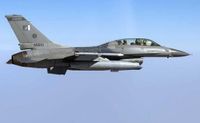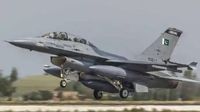In a significant escalation of tensions between India and Pakistan, Indian air defense units shot down a Pakistani F-16 fighter jet on the evening of May 8, 2025. This incident occurred amidst a flurry of missile and drone attacks launched by Pakistan across multiple locations in Jammu, prompting a robust response from India’s military forces.
According to reports, the Pakistani F-16 was targeted and destroyed by India’s surface-to-air missile defense system near the Sargodha air base, a key installation for the Pakistan Air Force. This air base, located approximately 270 kilometers from the international border, has been a focal point for air operations in past conflicts.
As the situation escalated, Pakistan initiated simultaneous attacks on various sites within Jammu, including the Jammu Civil Airport. The attacks involved the firing of drones and missiles, which triggered a comprehensive counter-offensive from India, including the deployment of advanced S-400 missile systems. Indian forces successfully intercepted eight incoming missiles aimed at strategic and civilian targets in Jammu, Samba, RS Pura, and Arnia, effectively neutralizing the threat.
Eyewitnesses reported hearing loud explosions and sirens in Jammu as the conflict unfolded. Local sources indicated that one drone struck near Jammu airport, while others were intercepted over Udhampur, Pathankot, and Akhnoor. In total, two additional drones were shot down near Jammu University, underscoring the intensity of the aerial confrontations.
In response to the escalating situation, power cuts were enforced in Jammu and Amritsar, aimed at supporting uninterrupted air defense operations. The Border Security Force (BSF) and Indian Army sealed off a 100-kilometer radius along the international border and the Line of Control (LoC), anticipating further Pakistani troop mobilization.
Reports from various news outlets confirmed that the Indian air defense system had effectively thwarted a series of Pakistani drone attacks, including those in Rajasthan's Jaisalmer region. The Indian military's swift actions included intercepting drones and missiles, which have been a persistent threat since the commencement of Operation Sindoor, launched by India just two days prior to these events.
The F-16, a prominent fighter jet in the Pakistani arsenal, was originally procured from the United States in the late 1980s. Its usage has been noted in previous conflicts, particularly during India's Balakot air strikes in 2019. The aircraft's downing marks a pivotal moment in the ongoing hostilities, which have seen a significant increase in military engagement along the border.
In addition to the aerial confrontations, heavy artillery shelling was reported along the LoC, particularly in the districts of Kupwara, Baramulla, Poonch, Samba, and Uri. The Pakistani military's unprovoked shelling further escalated the conflict, prompting heightened security measures across northern India. Sirens were sounded in major cities, including Chandigarh, as local authorities prepared for potential threats.
As the situation remains fluid, the Indian Armed Forces have been placed on high alert, with military stations in Jammu, Pathankot, and Udhampur being targeted by missile and drone strikes. The Integrated Defence Staff (IDS) stated that all threats were neutralized without any losses to Indian forces, emphasizing the effectiveness of their operational protocols.
The recent hostilities follow closely on the heels of India's Operation Sindoor, which targeted terror camps in Pakistan and Pakistan-occupied Kashmir, indicating that the current escalation may be a direct response to India's military actions.
With the conflict intensifying, both nations are bracing for potential further confrontations. The Indian government has declared holidays for schools in border districts, including Barmer, Bikaner, Sri Ganganagar, and Jaisalmer, as a precautionary measure.
In summary, the shooting down of the F-16 and the subsequent military exchanges underscore a precarious moment in India-Pakistan relations, with both sides demonstrating their military capabilities amid rising tensions. As the situation develops, the international community watches closely, hopeful for a de-escalation of hostilities.






